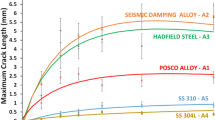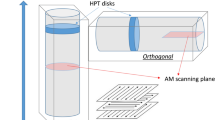Results of research on high-temperature tension for powder steels by the Swedish company Höganäs are analyzed. Morphological differences in the structure through the cross-section of a cylindrical specimen, which is conventionally divided into central and peripheral areas, are revealed. Microstructural analysis and fractographic study of the fracture surface are performed in each area. These studies provide identification of areas of fractures having different relief in intercrystalline shears and their extent, which indicates the presence of areas on the surface of interparticle contact with different degrees of completion of interparticle fusion. It is shown that plastic flow is accompanied by formation of peripheral region material whose structure and properties depend on the degree of deformation and production conditions. As the peripheral region develops material strength properties decrease after reaching a critical amount of transverse flow. Mechanical properties of specimens prepared from the highest quality materials are studied in detail at high temperature. This provides a complete picture of the occurrence of microcracks and the potential for using the material under actual conditions.












Similar content being viewed by others
References
Yu. G. Dorofeev, Dynamic Hot Compaction of Porous Powder Workpieces [in Russian], Metallurgiya, Moscow (1977).
Yu. G. Dorofeev, L. G. Marinenko, and V. I. Ustimenko, Structural Power Materials and Objects [in Russian], Metallurgiya, Moscow (1986).
G. A. Baglyuk, “Analysis of the kinematics of a porous cylinder free upsetting taking account of contact friction,” Poroshk. Metall., No. 1, 17–21 (1993).
V. V. Sinel’shchikov and A. S. Razymnyi, “Evaluation of porous material ductility in a heated condition for specimen free upsetting,” Powder and Composite Materials and Objects, coll. work, YuRGTU, Cherkassk (2005).
V. V. Sinel’shchikov, S. N. Egorov, and Yu. V. Dybov, “Study of features of failure of growth zones of heated porous material with uniaxial tension,” Progressive Technology of Engineering Systems: Proc. V Internat. Sci. Tech. Conf. “Engineering and Technosphere Abroad of the XXI Century” (Sevastopol’, 8–11 September 1998), DonGTYu, Donetsk (1998).
E. Robert-Perron, C. Blais, and S. Pelletier, “Tensile properties of sinter hardened powder metallurgy components machined in their green state,” Powder Metallurgy, 52, No. 1, 80–83 (2009).
V. N. Antsiferova, Problems of Contemporary Materials and Technology [in Russian], Perm. Gos. Tekh. Univ, Perm’ (1995).
Yu. G, Gurevich, V. N. Antsiferov, L. M. Savinykh, S. A. Oglezneva, and V. Ya. Bulanov, Wear Resistance of Composite Materials [in Russian], UrO RAN, Ekaterinberg (2005).
V. Yu. Dorofeev and Yu. G. Dorofeev, “Stamping of powder workpieces: today and tomorrow,” Poroshk. Metall., No. 7/8, 27–36 (2013).
M. S. Egorov, R. V. Egorova, V. N. Pustovoit, and A. A. Atrokhov, “Mechanical properties of powder materials after free upsetting,” Metallurg, No. 3, 93–96 (2020).
V. Yu. Dorofeev and S. N. Egorov, Particle Growth During Formation of Powder Hot-Deformed Materials [in Russian], Metallurgizdat, Moscow (2003).
A. K. Grigor’ev and A. I. Rudskoi, Powder Material Deformation and Compaction [in Russian], Metallurgiya, Moscow (2002).
G. A. Baglyuk, “Comparative analysis of the deformed state of porous workpieces during stamping in closed and open dies,” Obrab. Metall. Davleniem, No. 2, 147–153 (2012).
M. B. Shtern and E. V. Kartuzov, “Features of the occurrence of propagation and impact waves in highly porous materials,” Poroshk. Metall., No. 3, 13–22 (2016).
Zh. V. Eremeeva, N. M. Nikitin, N. P. Korobov, and Yu. S. Ter-Vaganyants, “Study of treatment of powder steels alloyed with anno-size additions,” Nanotekhnol: Nauka Proizvod., No. 1(38), 63–74 (2016).
M. S. Egorov and S. N. Egorov, “Hot-deformed low-alloy structural steels,” RF Ministry of Education and Science, Federal Agency for Education, YuRGTU (Novocherkassk Politech. Inst.), Novocherkassk (2008).
R. V. Egorova, “Microstructural analysis of a stepped shape surface,” Metallurg, No. 6, 65–67 (2009).
A. A. Mamonova, “Features of fine crystalline structure formation and optimization of powder steel stamping processes,” Author’s Abstr. Cand. Techn. Sci., Kiev (2007).
M. S. Egorov, and R. V. Egorova, “Ductility of composite materials with determination of hot stamping regimes excluding defect formation within the material structure,” Zagotvit. Proizvod. Mashin., 17, No. 2, 66–72 (2019).
A. A. Glotka and A. N. Moroz, “Comparative effect of carbides and nonmetallic inclusions on microcrack formation within steels,” Metalloved. Term. Obrab. Materialov, No. 8, 61–65 (2019).
Author information
Authors and Affiliations
Corresponding author
Additional information
Translated from Metallurg, Vol. 65, No. 3, pp. 73–81, March, 2021.
Rights and permissions
About this article
Cite this article
Egorov, M.S., Egorova, R.V. Relationship between Mechanical Properties and Nature of Fracture Surface of Powder Steels under High-Temperature Tension. Metallurgist 65, 326–339 (2021). https://doi.org/10.1007/s11015-021-01161-6
Received:
Published:
Issue Date:
DOI: https://doi.org/10.1007/s11015-021-01161-6




